The Featured Creatures collection provides in-depth profiles of insects, nematodes, arachnids and other organisms relevant to Florida. These profiles are intended for the use of interested laypersons with some knowledge of biology as well as academic audiences.
Introduction
Because of their striking appearance and their large size, beetles of the genus Alaus are commonly brought to the attention of nursery inspectors and Cooperative Extension Service agents. Three species in this genus, Alaus myops (Fabricius), Alaus oculatus (Linnaeus), and Alaus patricius (Candeze) are found in Florida.
Synonymy
Leng and Mutchler (1914) listed Alaus patricius under the generic name Calais but Blackwelder (1944) listed that name as a subgenus of Alaus. The latter placed Alaus luscus Olivier as a synonym of patricius, but Alaus luscus Fabricius is a synonym of oculatus.
Distribution
Alaus oculatus is widespread in the eastern United States, being recorded by Leng (1920: 167) from "Indiana, Atlanta States -- Texas, Florida." Blatchley (1910: 717) listed it from throughout Indiana; Fattig (1951: 5) listed 19 localities scattered over Georgia; and Dietrich (1945: 9) listed it as being found throughout the state of New York. The Florida State Collection of Arthropods (FSCA) contains records from the following Florida counties: Alachua, Columbia, Dade, Duval, Gulf, Hardee, Hillsborough, Orange, Palm Beach, Seminole, and St. Lucie. Becker (in literature) indicated that Alaus oculatus also occurs in southern Ontario and Quebec.
Alaus myops is more common in the southeastern United States although it is occasionally found in the northern states; recorded by Leng (1920: 167) reported from "Indiana, Middle and Southern States, Florida." Blatchley (1910: 719) listed one record for Indiana and stated "rare north of the Ohio River". Fattig (1951: 5) listed 20 localities scattered over Georgia. Dietrich (1945: 10) listed nine localities in New York. The FSCA contains records from the following Florida counties: Alachua, Baker, Brevard, Dade, Hardee, Highlands, Liberty, Monroe, Orange, Polk, and Seminole. A. myops also is known from the Montreal area to southern Manitoba.
Alaus patricius (Candeze) is present in the Florida Keys. Schaeffer (1909: 149) listed this species from Cuba and recorded the first United States specimen from Chokoloskee, Florida. Kimball (1965) discussed many records of foreign Lepidoptera from Chokoloskee and concluded that some were sold by a commercial collector and validity of the labels was doubtful. It is likely that Schaeffer's specimen was mislabeled also, but the three collected specimens served to confirm its presence in Florida, at least on Key Largo. Leng and Mutchler (1914: 426) listed A. patricius (under the generic name Calais) from Cuba only. Blackwelder (1944: 282) listed A. patricius from "Cuba, I. de Pinos, U.S.A."
Description
Adults
The adults reach a length of 24 to 45 mm (1–1 ¾ in). The photographs below illustrate why these beetles are so striking. The large "false eyes" on the pronotum of adults are characteristic of this genus. Presumably these spots have some selective value in frightening a would-be predator. The true eyes are much smaller and are located on the head anterior to the "false eyes." Both Florida species have a mottled pattern on the dorsal surface created by minute scales. These patterns are variable but similar to those shown in the photographs and are effective in concealment.
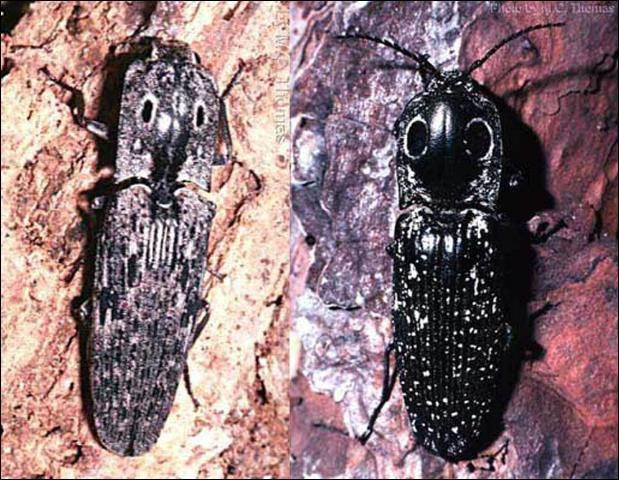
Credit: M.C. Thomas, Division of Plant Industry
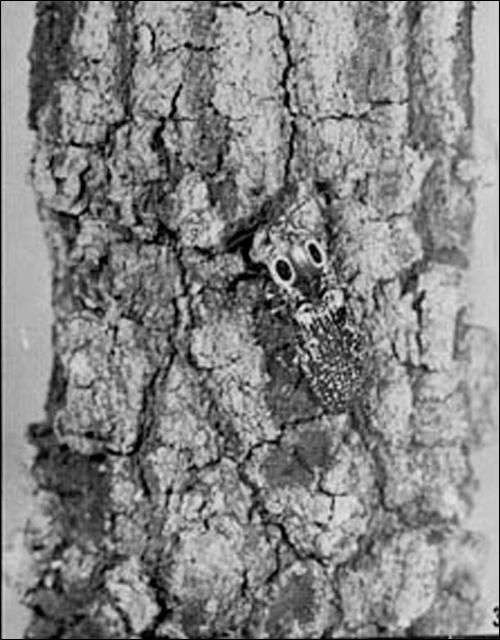
Credit: E.M. Collins, Jr, Division of Plant Industry
Larvae
The larvae are large (up to 2 inches), heavily sclerotized, smooth, stout, and yellowish to dark brown. That of Alaus oculatus is described technically by Jewett (1946: 16, Fig. 53-55) and Peterson (1951: 176, Fig. C46, K, L, M). The head is nearly black and the last four abdominal segments are dark brown. The last dorsal abdominal segment (9th) is armed with many conical tubercles and terminates in a pair of forked teeth (urogamphi). The 10th segment has two anal hooks and 10 to 12 spines and setae anterior to the anus. The spiracles are biforous, located on the ventral side of the mesothorax and on the dorso-lateral part of the first through eighth abdominal segments. I have not found a description or illustration of the larva of Alaus myops.
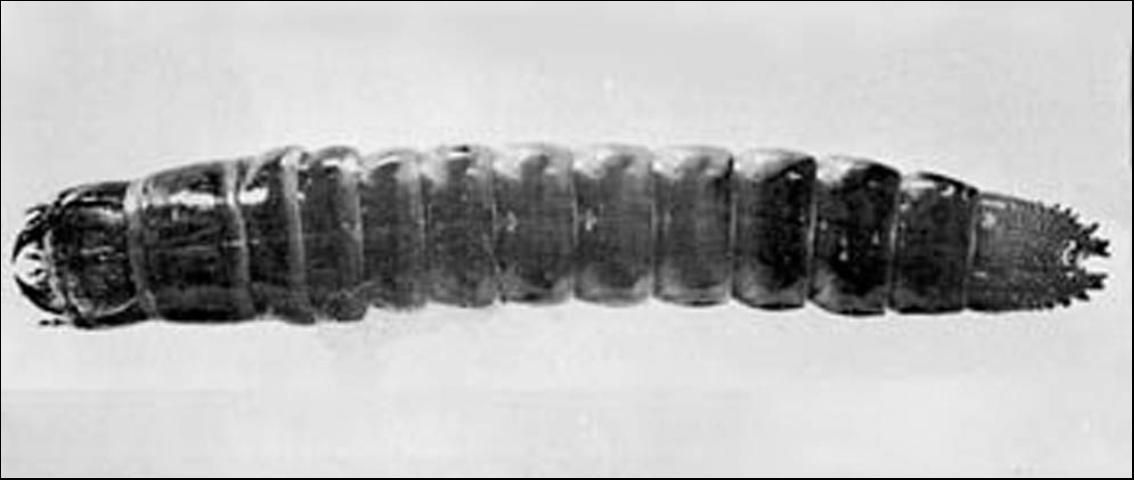
Credit: E.M. Collins, Division of Plant Industry
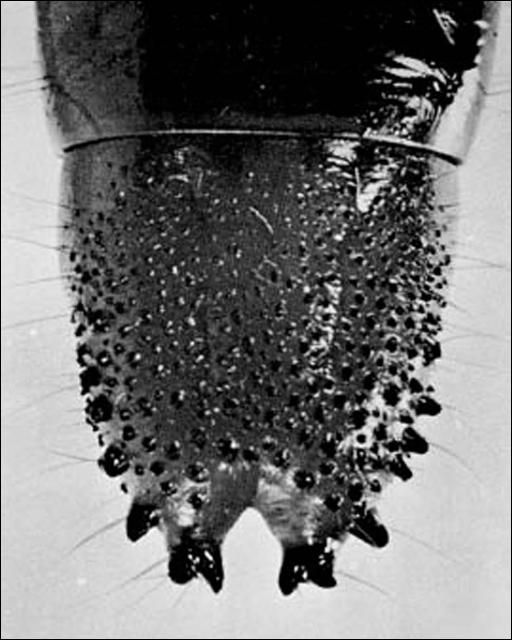
Credit: E.M. Collins, Division of Plant Industry
Alaus patricius is variable in length (30 to 35 mm (1 1/8–1 1/3 in)) and color but is similar to the other two Florida species. The body color is dark brown to black with a pattern of whitish scales on both dorsal and ventral surfaces. The scales are slightly rubbed on all specimens seen, so that the exact pattern is not visible. There is a brownish area (irregular band) just behind the middle of each elytron. There is a surprising similarity of the dorsal color pattern to that seen in several Oriental species. Eye spots of the pronotum are nearly absent in the female, but not noticeable (not prominent) in the male.
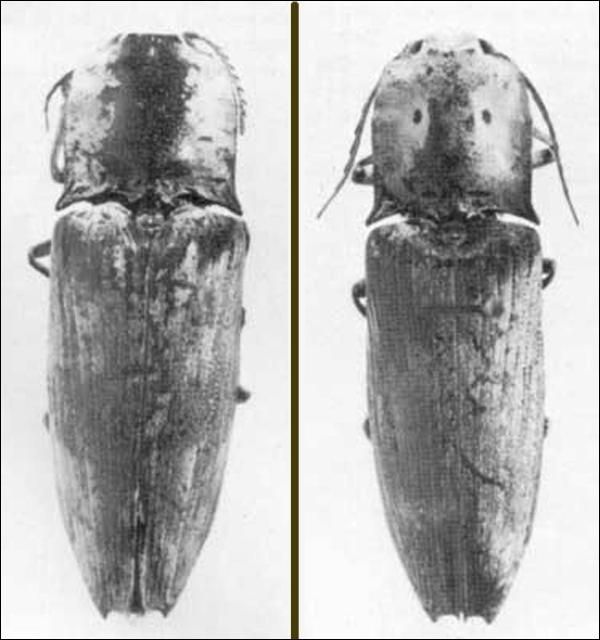
Credit: Steve Wadlington, Division of Plant Industry
Each elytron terminates in two spines in both sexes.
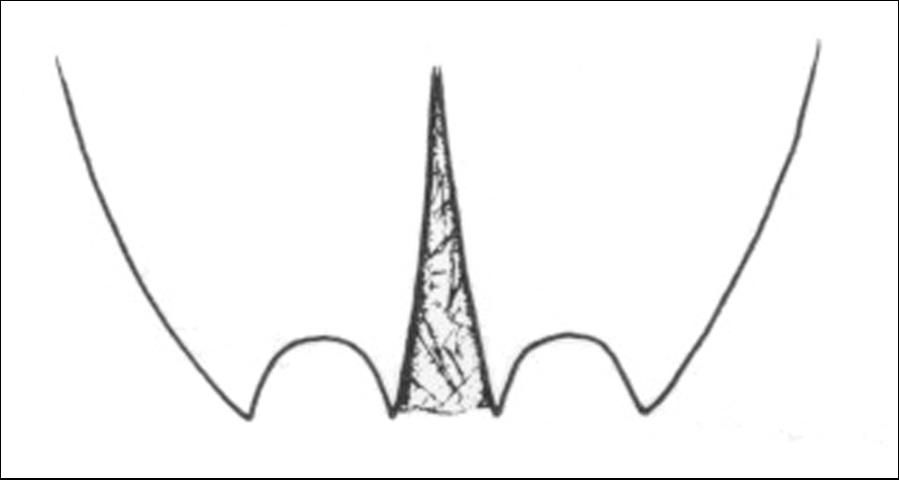
Male antennae are longer than the pronotum and more pectinate. Female antennae are about two-thirds the pronotal length and less pectinate.
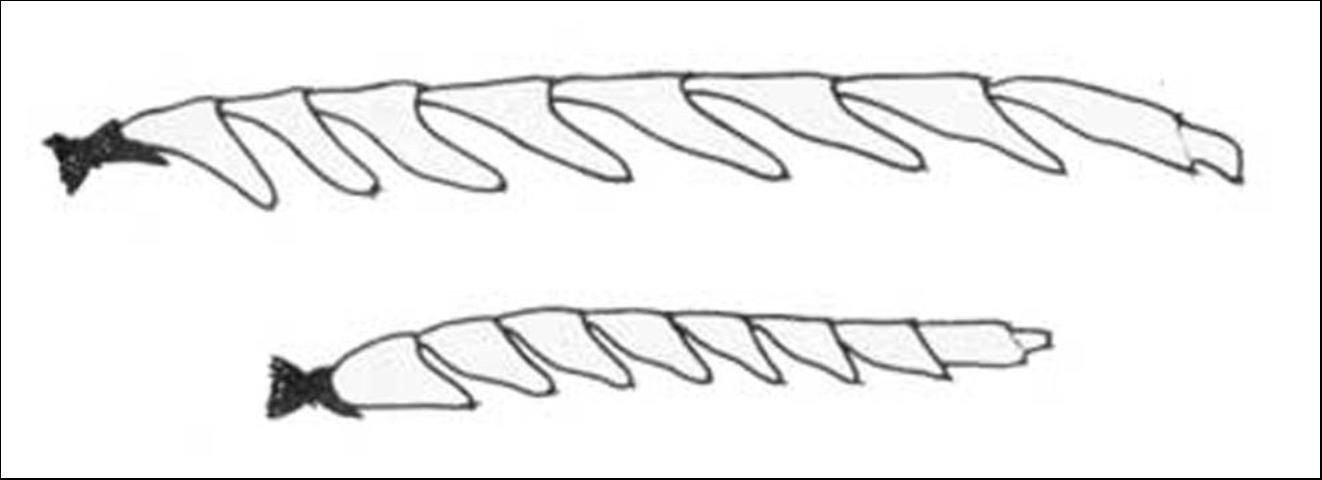
I have been unable to find any reference to the larva and presume that it is undescribed. However, it should be similar in general appearance to the images of Alaus oculatus.
Biology
The ferocious looking larva and the large beetle might be expected to be a serious pest. However, the adults probably feed little and the larvae are effective predators on many wood-boring beetle larvae. Craighead (1950: 185) stated that larvae of oculatus were voracious on wood borers, and that during their development caged specimens each devoured more than 200 cerambycid larvae. They are most often encountered in rotting stumps of oak, cherry, and apple, whereas myops is usually found in pine stumps and logs. Rohwer (1920: 443) listed Xorides catomus Davis (Ichneumonidae) as a parasite of the larvae.
Although I have found no specific reference to the biology of Alaus patricius, it is probably predaceous as a larva. The adults taken in Florida were all found on 25-V-74 at blacklight (ultraviolet).
Key to Florida Species of Alaus
Alaus patricius is easily distinguished from the other Florida species by the very small "eyespots," the color pattern and the doubly spined elytral apices.
1. "Eye spots" less than one-fourth the length of pronotum; base color or dorsum brownish, the scales mostly grey and covering more than half the surface; associated with pines. . . . . myops (Fabr.)
1'. "Eye spots" about one-third the length of the pronotum; base color or dorsum black, the scales mostly white and covering less than half the surface; associated with hardwoods. . . . . oculatus (Linn.)
2. Pronotal "eyespots" less than one-fourth pronotal length; base color brownish, the scales mostly grey and covering more than half the surface; associated with pines . . . . . myops (Fabricius)
2'. Pronotal "eyespots" about one-third pronotal length; base color black, the scales mostly white and covering less than half the surface; associated with hardwoods . . . . . oculatus (Linnaeus)
Acknowledgments
I thank the following for assistance during preparation of the material on Alaus patricius: Hermann Flaschka, Chemistry Department, Georgia Institute of Technology, Atlanta, Georgia, who collected the specimens; E.C. Becker, Biosystematics Research Institute, Agriculture Canada, Ottawa, Canada, who confirmed the identification; N.M. Downie, Psychology Department, Purdue University, Lafayette, Indiana, who first called the specimens to my attention; and Steve Wadlington, Florida Department of Agriculture and Consumer Service, Division of Plant Industry, who took the photographs.
Selected References
Blackwelder RF. 1944. Checklist of the coleopterous insects of Mexico, Central America, the West Indies, and South America. United States National Museum Bulletin 185: 189–341.
Blatchley, W.S. 1910. Coleoptera or Beetles Known to Occur in Indiana. Nature Publishing Company, Indianapolis, IN 1385 p.
Craighead, F.C. 1950. Insect Enemies of Eastern Forests. USDA Miscellaneous Publication 657: 1–679.
Dietrich, Henry. 1945. The Elateridae of New York State. Cornell University Agricultural Experiment Station Memorandum 269: 1–79.
Fattig, P.W. 1951. The Elateridae or click beetles of Georgia. Emory University Museum Bulletin 10: 1–25.
Jewett, H.H. 1946. Identification of some larval Elateridae found in Kentucky. Kentucky Agricultural Experiment Station Bulletin 489: 1–40.
Kimball CP. 1965. The Lepidoptera of Florida; an annotated checklist. Arthropods of Florida and neighboring land areas 1: i-v, 1–363; Florida Department of Agriculture and Consumer Services, Division of Plant Industry, Gainesville.
Knull, J.N. 1932. Notes on Coleoptera. - No. 3. Entomological News 43: 42–45.
Leng, C.W. 1920. Catalogue of the Coleoptera of America, North of Mexico. John D. Sherman, Jr., Mount Vernon, N.Y. 470 p.
Leng CW, Mutchler AJ. 1914. A preliminary list of the Coleoptera of the West Indies as recorded to January 1, 1914. Bulletin of the American Museum of Natural History 33: 391–493.
Pechuman, L.L. 1937. An annotated list of insects found in the bark and wood of Ulmus americana L. in New York State. Bulletin of Brooklyn Entomological Society 32: 8–21.
Peterson, Alvah. 1951. Larvae of Insects; Part II -- Coleoptera, Diptera, Siphonaptera, Mecoptera, Trichoptera. Edwards Bros., Inc., Ann Arbor, Mich. 416 p.
Rohwer, S.A. 1920. The North American ichneumon-flies of the tribes Labenini, Rhyssini, Xoridini, Odontomerini, and Phytodietini. Proceedings of the U.S. National Museum 57: 405–474.
Schaeffer C. 1909. Three Cuban Coleoptera new to the fauna of the United States. Journal of the New York Entomological Society 17: 148–150.